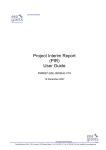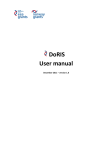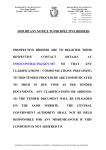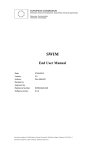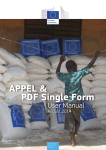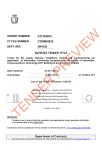Download Project Interim Report for Block Grants and Programmes (FUND PIR
Transcript
Project Interim Report for Block Grants and Programmes (FUND PIR) User Guide FM0027-GDL-00037-E-V8 14 December 2007 Financial Mechanism Office, 12-16 Rue Joseph II, 1000 Brussels, Belgium . Tel: +32 (0)2 286 1701 . Fax: +32 (0)2 286 1789 . Email: [email protected] . www.eeagrants.org Page 2 of 11 1. FM0027-GDL-00037-E-V8 Introduction The Project Interim Report for Block Grants and Programmes (FUND PIR) is a structured reporting format provided by the Financial Mechanism Office (FMO) and completed by the Project Promoter. According to the Financial Mechanisms’ legal framework, the PIR forms an integral part of the project planning and reporting structure, as the following diagram shows. Application Form (APF) Grant Agreement & Project Impl. Plan (PIP) Project Interim Report (PIR) = Payment claim Project Completion Report (PCR) Figure 1: project planning and reporting structure The FUND PIR is relevant for the projects fulfilling the following conditions: - the project involves re-granting and - the disbursements from the Financial Mechanism to the Project Intermediary are made as advance instalments. The completed FUND PIR will serve as basis for the Promoter’s pre-financing requests as well for the Paying Authoritie’s incurred expenses certification to the FMO. It will serve also as information base for monitoring the performance of a project in terms of its scope, schedule, pre-financing and actual incurred expenses. That means that the submitted FUND PIR (including individual pre-financing request) will be compared against the Project Implementation Plan (PIP). Only one FUND PIR should be completed even if the project is financed by both the EEA and Norwegian Financial Mechanism. Regarding the FUND PIR completion procedure, the FMO will generate a tailor-made FUND PIR template and send it electronically to the Project Promoter through the Focal Point approximately 20 days before the last day of the planned reporting period end month (as defined in Part V of the PIP). The Project Promoter shall fill in the FUND PIR and return it electronically along with a signed hard copy to the Focal Point. The Focal Point certifies the project progress and indicators and forwards the certified FUND PIR, both the electronic and hard copy versions, to the Paying Authority. The Paying Authority certifies the incurred expenses and co-financing before it submits a request for pre-financing to the FMO. Fully certified and signed FUND PIRs must be sent by post to the FMO. An identical electronic version of the FUND PIRs must be sent to a dedicated e-mail address provided by the FMO to the Paying Authority. Note that the Paying Authority will not normally forward any additional supporting documentation to the FMO. The last FUND PIR shall also be submitted to the FMO in the way described above. Within 10 working days of processing the last FUND PIR, the FMO will generate a tailor-made Project Completion Report (PCR) template for the project and send it electronically to the Project Promoter through the Focal Point. For further details regarding disbursements, reporting and monitoring please refer to the Disbursement guidelines and Reporting and monitoring guidelines made available on the web site, www.eeagrants.org. This user guide describes in detail how to complete the FUND PIR and specifies the information required in particular fields. Financial Mechanism Office, 12-16 Rue Joseph II, 1000 Brussels, Belgium . Tel: +32 (0)2 286 1701 . Fax: +32 (0)2 286 1789 . Email: [email protected] . www.eeagrants.org Page 3 of 11 2. FM0027-GDL-00037-E-V8 General form usage points to complete the FUND PIR The following points need to be considered when completing the FUND PIR: - The FUND PIR is a Microsoft Excel Workbook. It is compatible with versions of this software from Excel 97 onwards, although the use of versions more recent that Excel 2000 is strongly recommended; - The FUND PIR contains no Excel macros; - Editable cells are light blue in colour; all other cells are locked and not editable by the user. - Do NOT use cut/paste to move data from one part of the form, as this disrupts the form’s structure; - Do NOT drag entire cells by selecting the periphery for the same reason; - To copy the data from another sheet / another place in the same sheet: o copy the data from the source sheet (ctrl – C) o select the destination cells, and use ‘Paste Special’ with the ‘Values’ checkbox selected to paste data: Extending data from one cell to another by dragging the bottom right hand corner of the border is acceptable. Financial Mechanism Office, 12-16 Rue Joseph II, 1000 Brussels, Belgium . Tel: +32 (0)2 286 1701 . Fax: +32 (0)2 286 1789 . Email: [email protected] . www.eeagrants.org Page 4 of 11 3. FM0027-GDL-00037-E-V8 Detailed description of FUND FUND PIR fields This section describes the data in the FUND PIR. This data comes from three sources: o entered by the Project Promoter o gathered by the FMO from the Application Form and Project Implementation Plan (PIP) o calculated to provide information to the Project Promoter 3.1. Project Promoter This section of the FUND PIR is provided for reference, and requires no input from the Project Promoter. If any of the details in this section are incorrect, then the Project Promoter should inform the Focal Point without delay. [0.1] Full Legal Name Populated with the information supplied in the Application Form associated with this FUND PIR. [0.2] Contact Person The name of the primary contact for the project. Whilst the vast majority of correspondence between the Promoter and the FMO will be via the Focal Point, any direct communication from the FMO to the Project Promoter will be addressed to this person. [0.3] Job Title The job title of the person named in [0.2]. [0.4] Organisation The name of the organization to which the person named in [0.2] belongs. In many cases this will be a department within the Promoter’s organization named in [0.1], but may be a separate entity if the contact person is not part of that organization. [0.5] Address The correspondence address for the person named in [0.2]. [0.6] Telephone The fixed line telephone number for the person named in [0.2]. [0.7] Mobile The mobile telephone number for the person named in [0.2]. [0.8] Fax The fax number for the person named in [0.2]. [0.9] Email The email address of the person named in [0.2]. 3.2. PART I - Signature This section of the FUND PIR is only provided for signature by the Project Promoter. An authorized person for the Project Promoter must confirm the information provided. 3.3. PART II – Project Progress Summary This section of the FUND PIR summarizes the status of the project progress as a whole. Financial Mechanism Office, 12-16 Rue Joseph II, 1000 Brussels, Belgium . Tel: +32 (0)2 286 1701 . Fax: +32 (0)2 286 1789 . Email: [email protected] . www.eeagrants.org Page 5 of 11 [2.1] FM0027-GDL-00037-E-V8 Project Title The project title as defined in the application Form. [2.2] Project Number The project number assigned by the FMO on registration of the Application Form. All correspondence relating to this project should make reference to this number. [2.3] Total Grant Rate Awarded The ratio of grant awarded by the Financial Mechanism Committee (FMC) and/or Norwegian Ministry of Foreign Affairs (NMFA) to the eligible cost of the project, as defined in the Grant Agreement (PIP field [1.14]). [2.4] Total Grant Awarded (Euro) The total grant awarded under one or both mechanisms, as defined in the Grant Agreement (PIP field [1.12]). Project Progress Summary [2.5] Actual total expense this period (Euro) The actual total incurred expenditure this reporting period [5.1] [5.2] summed across all the activities in Part VI of the FUND PIR. This figure includes cash eligible expenses [6.15], government budget in-kind eligible expenses [6.16], non-public in-kind eligible expenses [6.17] and non-eligible expenses [6.18]. [2.6] Project actual start date The month in which work started on the project as defined by the PIP. [2.7] Project planned start date The month in which the project was planned to start (PIP field [1.6]). [2.8] Project estimated completion date The best estimate, on the day of submission of the FUND PIR, of the month/year in which the project will finish. [2.9] Project planned completion date The month in which the project was planned to finish (PIP field [1.7]). [2.10] Project estimated percentage complete The best estimate, on the end date of the reporting period [5.2], of the percentage of the project scope as defined in the indicators that have been completed. This is a key parameter used by the FMO in completing actual project progress of the plan, and it is thus very important that meaningful information is supplied in this field. The indicators constitute the formal definition of the project scope – however the percentage completion is not simply the numerical progress in achieving the target. In many cases there will be no simple linear relationship between the indicator status in numerical terms and the estimated percentage complete – what is expected is a judgment call by the Project Promoter. Please note that this parameter must NOT be calculated from the proportion of the actual total expenses to the date to the planned overall total expenses. If the project estimated percentage complete is indicated as 100% in a FUND PIR, the FMO will consider it as the last FUND PIR for the project. After processing the FUND PIR, the FMO will generate a tailormade Project Completion Template (PCR) for completion by the Project Promoter. [2.11] Brief description of actual project progress versus planned A description of the progress made in achieving the scope of the project, with comparison to the expected. Financial Mechanism Office, 12-16 Rue Joseph II, 1000 Brussels, Belgium . Tel: +32 (0)2 286 1701 . Fax: +32 (0)2 286 1789 . Email: [email protected] . www.eeagrants.org Page 6 of 11 FM0027-GDL-00037-E-V8 3.4. PART III – Pre-financing Summary This section of the FUND PIR summarizes the pre-financing status of the project. [3.1] Start date of reporting period The month in which this reporting period starts (PIP field [5.8]). [3.2] End date of reporting period The month in which this reporting period finishes (PIP field [5.9]). [3.3] Pre-financing Request Number The number of this pre-financing request (PIP field [5.7]). [3.4] Percentage cash co-financing from non-public sources The percentage of the cash co-financing that is provided from non-public sources, (PIP field [5.4]). Following table compare the actual pre-financing request from this reporting period against the plan, and has two columns: - Actual Amount (Euro) - Planned Amount (Euro) ‘Actual Amount (Euro)’ column summarizes the status from this FUND PIR. ‘Planned Amount (Euro) column represents the planned pre-financing request stipulated in PIP, fields [5.12], [5.13] and [5.14]. [3.5] Financial Mechanism Grant The amount that will be disbursed. The same as [3.15]. [3.6] Cash co-financing to be committed – this PIR: Government budget Calculated: [3.16] x (1 - [3.4]). [3.7] Cash co-financing to be committed – this PIR: Non-public Calculated: [3.16] – [3.6]. Pre-financing Expenses Funding Summary (Euro) This table shows how the project pre-financing expenditure and funding is evolving over time, and has three columns: Pre-financed to date This reporting period Total to date The ‘Pre-financed to date’ column summarizes the state of the project when the previous FUND PIR was submitted. If this is the first FUND PIR (# 1) then information in this column can only refer to an advance payment, if one has been made on this project. ‘This reporting period’ summarizes the change to the project parameters from this FUND PIR. ‘Total to date’ is the sum of the first two columns. Note that the ‘Total to date’ column in FUND PIR #n is brought forward to be the ‘Pre-financed to date’ in FUND PIR #n+1. As non-eligible expenses are by definition not funded by the Financial Mechanisms, they are not considered in this table. The descriptions below focus on the source of the data in the ‘Next reporting period’ column. Financial Mechanism Office, 12-16 Rue Joseph II, 1000 Brussels, Belgium . Tel: +32 (0)2 286 1701 . Fax: +32 (0)2 286 1789 . Email: [email protected] . www.eeagrants.org Page 7 of 11 [3.8] FM0027-GDL-00037-E-V8 Cash eligible expenses The total cash eligible expenses reported under each activity in [4.6] summed across all pre-financing activities. [3.9] In-kind contribution The total in-kind eligible expenses reported under each activity in [4.7] and [4.8] summed across all prefinancing activities. [3.10] Total eligible expenses The total of [3.8] and [3.9]. [3.11] Advance offset The amount deducted from the cash eligible expenses [3.8] to offset any initial advance payment. The advance offset is calculated according to the following rules: o As much of the cash eligible expenses to be reimbursed up to the planned advance offset (PIP field [5.11]) will be used to offset the advance. o A shortfall in the advance offset from one reporting period (due to the cash eligible expenses in the period being less than the planned advance offset) is carried forward to the next reporting period, and so on until the shortfall is made up. [3.12] Cash eligible expenses less advance offset The cash eligible expenses that will actually be reimbursed, excluding any retention for project completion. This is calculated from the total ‘Cash eligible expenses’ [3.8] less the ‘Advance offset’ [3.11]. [3.13] Financial Mechanism Disbursement prior to project completion retention The ‘cash eligible expenses’ [3.8] less ‘advance offset’ [3.11] plus ‘in-kind contribution’ [3.9], multiplied by the actual grant rate for ‘Next reporting period’ [3.18]. This figure is included to clarify the calculation. [3.14] Retained for project completion The amount to be retained from the ‘Financial Mechanism disbursement prior to project completion retention’ [3.13] that will be paid on project completion. This is calculated according to the following rules: - If this FUND PIR is not the last FUND PIR (which must be the case if the project estimated percentage complete [2.10] is not equal to 100%) funds are not retained for project completion until the following total eligible expenses threshold has been reached: Total grant awarded ([2.4]) – Planned amount retained for project completion (PIP [5.5] x PIP [2.6]) Grant rate awarded ([2.3]) - Once that threshold has been reached, as much of the ‘Financial Mechanism disbursement prior to project completion retention’ [3.13] up to the planned amount retained for project completion (PIP [5.5] * PIP [2.6]) is deducted from [3.13]. - If the amount to be retained for project completion cannot be retained from a single FUND PIR, the outstanding amount is carried forward to the next FUND PIR. - if this FUND PIR is the last FUND PIR, then the maximum amount of cash available up to the outstanding planned amount retained for project completion is deducted from the disbursement to be made by the Financial Mechanism(s). [3.15] Financial Mechanism Disbursement The amount that the Financial Mechanism(s) will disburse for the pre-financing request made in this FUND PIR. This is calculated from the Financial Mechanism disbursement prior to project completion retention [3.13], less amount retained for project completion [3.14]. Financial Mechanism Office, 12-16 Rue Joseph II, 1000 Brussels, Belgium . Tel: +32 (0)2 286 1701 . Fax: +32 (0)2 286 1789 . Email: [email protected] . www.eeagrants.org Page 8 of 11 FM0027-GDL-00037-E-V8 [3.16] Cash Co-financing The cash co-financing, associated with this reporting period, that has to be made available to the project. This is calculated from the total cash eligible expenses for the reporting period [3.8], less the advance offset [3.11], less the Financial Mechanisms disbursement prior to retention for project completion [3.13]. [3.17] Cash Eligible Expenses Funding. The total cash to be pre-financed. The total of [3.15] and [3.16]. [3.18] Actual grant rate The ratio of the Financial Mechanisms disbursement prior to retention for project completion [3.13] to the sum of cash eligible expenses funding [3.17] and in-kind contribution [3.9]. The actual grant rate for a single reporting period is calculated according to the following rules: 1. The amount in the ‘Total to date’ column must never exceed the grant rate awarded by the Financial Mechanisms [2.3]. The calculation of the grant rate in a single reporting period aims to make the ‘Total to date’ grant rate as close as possible to [2.3], taking total eligible expenses to date into account. 2. The grant rate in a single reporting period can never be less than 0% and can never exceed 100%. 3. The total grant paid ([3.15], ‘Total to date’ column) must never exceed the total grant awarded by the Financial Mechanisms ([2.4]). 3.5. PART IV – Pre-financing [4.1] Activity number Self-explanatory, based on the PIP field [4.1]. [4.2] Activity title Self-explanatory, based on the PIP field [4.2]. [4.3] Current estimate of pre-financing (Euro) The current estimation of total expenses to be pre-financed for the next period and for this activity. This figure includes Cash eligible expenses [4.6], Government budget in-kind eligible expenses [4.7] and Non public in-kind eligible expenses [4.8]. [4.4] Planned total pre-financing (Euro) The planned total pre-financing in Euro is extracted from the corresponding activity in Part IV of the latest approved PIP for this project. Where the reporting period does not correspond exactly to a PIP budgeting period, a monthly average expenditure is calculated from the PIP. [4.5] Brief description of activities to be pre-financed Concise description of the activities to be pre-financed. [4.6] Cash eligible expenses – Euro The cash eligible expenses to be pre-financed and that are uniquely associated with this activity. [4.7] Government budget in-kind eligible expenses – Euro The actual value of any eligible in-kind contribution from government sources which are uniquely associated with this activity. [4.8] Non-public in-kind eligible expenses – Euro The actual value of any eligible in-kind contribution from non-public sources and that is uniquely associated with this activity. Financial Mechanism Office, 12-16 Rue Joseph II, 1000 Brussels, Belgium . Tel: +32 (0)2 286 1701 . Fax: +32 (0)2 286 1789 . Email: [email protected] . www.eeagrants.org Page 9 of 11 FM0027-GDL-00037-E-V8 3.6. PART V – Incurred Expenses Summary and Certification This section summarizes the incurred expenses associated with this FUND PIR, and provides a sign-off for them. [5.1] Start date of reporting period The start date of the reporting period associated with this FUND PIR, (PIP field [5.8]). [5.2] End date of reporting period The end date of the reporting period associated with this FUND PIR, from PIP field [5.9]. [5.3] Total incurred expenses on the project The amount of total incurred expenses on the project across all the activities associated with this reporting period. Sourcing from [6.3] this FUND PIR. [5.4] Cash co-financing committed to the project – previous PIR / advance payment: Government Budget Sourcing from [3.6] in previous FUND PIR (if this is the first FUND PIR then this value is taken from the proportion of the advance payment paid from the Government budget). [5.5] Cash co-financing committed to the project – previous PIR / advance payment: Non-public Sourcing from [3.7] in previous FUND PIR (if this is the first FUND PIR then this value is taken from the proportion of the advance payment paid from non-public sources). Signature The Paying Authority must certify the incurred expenses and cash co-financing before submitting it to the FMO. 3.7. PART VI – Incurred Expenses [6.1] Activity Number Self-explanatory, based on the PIP field [4.1]. [6.2] Activity Title Self-explanatory, based on the PIP field [4.2]. [6.3] Actual total incurred expense this period (Euro) The actual total incurred expenditure for this reporting period for this activity. This figure includes cash eligible expenses [6.15], government budget in-kind eligible expenses [6.16], non-public in-kind eligible expenses [6.17] and non-eligible expenses [6.18]. [6.4] Estimated / actual start date If the activity has not yet started, the month in which work is likely to start. If the activity has started, the month in which it did so. [6.5] Planned start date The month in which work on the activity was planned to start (PIP field [4.4]). [6.6] Estimated /actual completion date If the activity has not yet started or is in progress, the month in which work is likely to be completed. If the activity has been completed, the month in which it did so. Financial Mechanism Office, 12-16 Rue Joseph II, 1000 Brussels, Belgium . Tel: +32 (0)2 286 1701 . Fax: +32 (0)2 286 1789 . Email: [email protected] . www.eeagrants.org Page 10 of 11 FM0027-GDL-00037-E-V8 [6.7] Planned completion date The month in which the work on the activity was planned to be completed (PIP field [4.5]). [6.8] Estimated percentage complete The best estimate, on the end date of the reporting period [5.2], of the percentage of the scope of the activity that has been completed. This is a key parameter used by the FMO in comparing actual project progress to the plan, and it is thus very important that meaningful information is supplied in this field. Please note that this parameter must NOT be calculated from the proportion of the actual total expenses to date for the activity to the planned overall total expenses - what is expected is a judgment call by the Project Promoter. [6.9] Brief description of actual activity progress versus planned A description of the progress made in achieving the scope of the activity, with comparison to that described in the latest approved PIP. This should focus on: - progress towards measurable deliverables from the activity; - status of risks recorded against the activity in the PIP; - identified issues hindering progress. You must never exceed the space provided in the text box. [6.10] Cash eligible expenses – local currency The actual incurred cash eligible expenses that are uniquely associated with this activity. [6.11] Government budget in-kind eligible expenses – local currency The actual value of any incurred eligible in-kind contribution from government sources that is uniquely associated with this activity. [6.12] Non-public in-kind eligible expenses – local currency The actual value of any incurred eligible in-kind contribution from non-public sources that is uniquely associated with this activity. [6.13] Non-eligible expenses – local currency The actual incurred cash non-eligible expenses associated with this activity. [6.14] Exchange rate This data is provided by the FMO according to the rule described in Disbursement Guidelines, section 3.1. [6.15] Cash eligible expenses – Euro The local currency value in [6.10] converted to Euros by the application of the exchange rate in [6.15]. [6.16] Government budget in-kind eligible expenses – Euro The local currency value in [6.11] converted to Euros by the application of the exchange rate in [6.15]. [6.17] Non-public in-kind eligible expenses – Euro The local currency value in [6.12] converted to Euros by the application of the exchange rate in 6.15]. [6.18] Non-eligible expenses – Euro The local currency value in [6.13] converted to Euros by the application of the exchange rate in 6.15]. Project Indicators The FUND PIR requires a quantitative report in column [6.22] on the progress to date on achieving the project results as defined in the PIP. Columns [6.19], [6.20], [6.21] and [6.23] are from PIP columns [3.9], [3.10], [3.11] and [3.12] respectively. Financial Mechanism Office, 12-16 Rue Joseph II, 1000 Brussels, Belgium . Tel: +32 (0)2 286 1701 . Fax: +32 (0)2 286 1789 . Email: [email protected] . www.eeagrants.org Page 11 of 11 FM0027-GDL-00037-E-V8 3.8. PART VII – Cross Cutting Issues and Risk Analysis Summary This section, i.e. the table and text boxes, will only appear in the FUND PIR which includes the month of December. The fill-in text boxes are to be completed by the Project Promoter when they appear in the FUND PIR. Any changes compared to previous FUND PIRs, which included this section, or to the Application Form has to be explained and justified. The Project Promoter shall take into consideration the contribution of the project to the cross-cutting issues when evaluating the project progress. The attached table should advise the Project Promoter to comment only on the project relevant cross cutting issues, crossed in the last two columns, which are: - Important part of the project and - Fundamental to the project. Accordingly, a brief description shall be provided with regard to the changes to the corresponding calendar year. The Risk Analysis summary has to cover the answers to the following questions: - Has a new risk (other than mentioned in the Application form) occurred during the monitored year? - Is there a change in the “likelihood” of already described risks compared to the description in the Application form during the monitored year? - Is there a change in the “impact” of already described risks compared to the description in the Application form during the monitored year? - During the monitored year, has the Promoter implemented some new measures (other than mentioned in the Application form) to mitigate the risk? Examples of the Risk Analysis summary The identified risks in the application were related to cash flow, delays due to the tendering process, and difficulties due to unforeseen discoveries of conservatory nature. In the last year, the cash flow has been acceptable and has not caused any problems to the project. As we are now well into the project, the likelihood for cash flow problems is now reduced from medium to low. The impact of such problems is still to be considered high. The tendering process is completed with only minor delays which are being compensated by a more tight time plan and the completion date is not changed. The likelihood for delays is still considered to be medium. The impact of delays is still considered to be medium. As the ground works have just started, the likelihood for and the impact of difficulties due to unforeseen discoveries of conservatory nature is the same as in the application, which is medium for both. Due to severe whether conditions just after the works started, some extra costs was spent to compensate for mud slides and removing of water being trapped on the building site. This was a risk not foreseen in the application and could only partly be compensated by the contractors responsibility. The building site has been better secured and the insurance has been extended to avoid such incidents to have any serious impact in the future. The likelihood is considered to be low as the weather conditions experienced were very unusual. The impact to the project is also low due to the measures taken. The applicant will cover the additional costs caused by the incident and the preventive measures. See the financial figures and comments. Project Progress signoff This section of the FUND PIR is only provided for signature by the Focal Point. Financial Mechanism Office, 12-16 Rue Joseph II, 1000 Brussels, Belgium . Tel: +32 (0)2 286 1701 . Fax: +32 (0)2 286 1789 . Email: [email protected] . www.eeagrants.org











